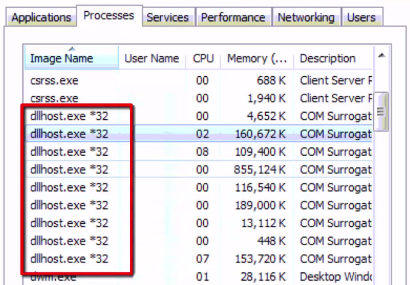This time it’s definitely a nontrivial issue that we are going to cover in an article. The story is about a malicious code that exploits the dllhost.exe COM Surrogate, an important Windows process. The danger of this bug consists in the probability of system resources exhaustion as it consumes a lot of the computer’s CPU. So get a full virus profile and learn the how-to’s on cleanup of the infected PC.
For disambiguation’s sake, it would be judicious to begin this malware report with the following remark: there is nothing unsafe about COM Surrogate as such. It is one of the critical Windows entities which is tasked with the objective of hosting other processes. Whenever the operating system encounters a potentially unstable process, it makes use of dllhost.exe*32 COM Surrogate in order to keep some important OS layers and components from crashing in the event something goes wrong with execution. That’s the reason why the object in question is also called sacrificial. Sadly enough, there is a computer virus in the wild, which exploits this process. This malign code is referred to as Trojan.Poweliks. It doesn’t appear to do a very good job obfuscating its activity when running, because the compromised machine slows down far and away. Having noticed the sluggish performance, users normally bring up the Task Manager window and end up seeing the following thing: there are multiple entries listed for dllhost.exe *32, with COM Surrogate in the Description field.

Aside from the redundancy of identical processes leading to memory exhaustion, the Trojan also deploys some unsafe activity in the background. It can promote other nasty software into the PC, provide attackers with remote system access capability, and lead to identity theft problems. Another fairly common symptom of the contamination is Windows alerts popping up to notify the user that COM Surrogate has stopped working. This is but one of the reasons to get down to some troubleshooting and malware cleaning.

As far as the fix for this problem goes, it’s about removing the malicious Trojan rather than trying to fix the supposedly ‘broken’ COM Surrogate process. So it all basically comes down to running a system scan with reliable security software to detect the malware, eliminate all of its components and perform automatic remediation of the system changes made by the virtual pest in question.
Automatic removal of the COM Surrogate virus
When it comes to handling infections like this one, using a reputable cleaning tool is the place to start. Sticking to this workflow ensures that every component of the adware gets found and eradicated from the affected computer.
1. Download and install the cleaning tool and click the Start Computer Scan button Download Dllhost.exe*32 COM Surrogate removal tool
2. The wait is worth it. Once the scan completes, you will see a report listing all malicious or potentially unwanted objects detected on your PC. Go ahead and click the Fix Threats option in order to get Dllhost.exe*32 COM Surrogate adware automatically uninstalled from your machine along with all of its modules. This being done, you should be good to go.


This is truly useful, thanks.
This is actually useful, thanks.